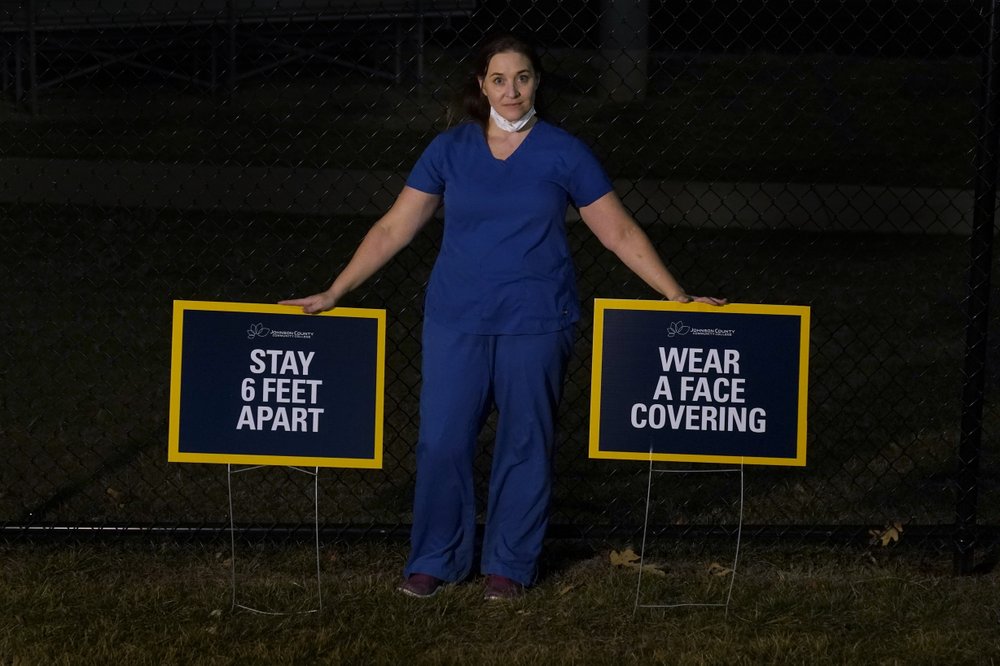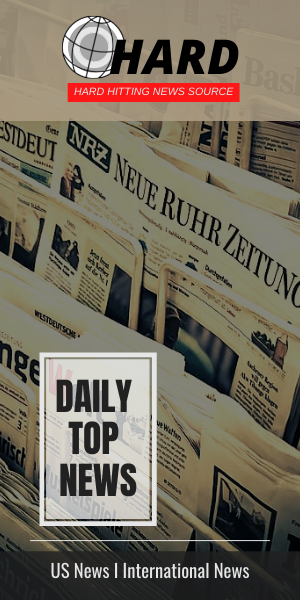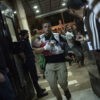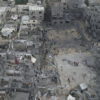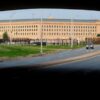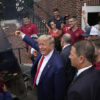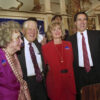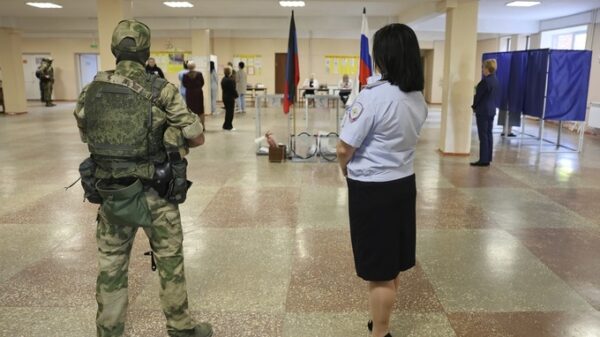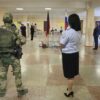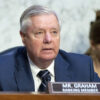Emergency room nurse L’Erin Ogle poses with coronavirus signs after getting off a 12-hour shift at a nearby hospital where she works Monday, March 8, 2021, in Overland Park, Kan. After a year of working long hours taking care of COVID-19 patients, Ogle feels obligated to speak out when she sees misinformation related to the pandemic in her community. (AP Photo/Charlie Riedel)
Hugging loved ones. Shaking hands. Going to school. Grabbing dinner at a restaurant. Visiting elderly family members.
Most Americans didn’t know this week last year was their last chance at normalcy. And while people have learned to adjust, the coronavirus pandemic has upended — and taken — millions of lives across the globe. Add the upheaval of a nation’s reckoning with racism and injustice along with a historic presidential election, and the pandemic year becomes more than about the virus. It’s also the year racial, socioeconomic and health care issues have demanded attention.
The Associated Press was there — for all of it. From the day the World Health Organization officially declared the coronavirus a pandemic to the first clinical trial of a vaccine and chronicling the path to a new normal, here is a taste of AP’s storytelling about every corner of the world as a jumbled, sometimes wrenching, year unfolded.
THE ECONOMY
From India to Argentina, untold millions who were already struggling to get by on the economic margins had their lives made even harder by pandemic lockdowns, layoffs and the loss of a chance to earn from a hard day’s work. Uncertainty became the order of the day.
In America, the most heavily hit were the front line workers who pack and deliver supplies, care for the sick and elderly, and keep streets and buildings clean. They are mostly women, people of color and more likely to be immigrants. Mothers, in particular, have been disproportionally pushed out of the workforce in the U.S. as the pandemic leaves parents with fewer child care options and the added burden of navigating distance learning.
Meanwhile, small businesses around the world have been fighting for survival amid the economic fallout from the pandemic. AP journalists told the stories of those struggling businesses, which help define and sustain neighborhoods. The stakes for their survival are high: The U.N. estimated that businesses with fewer than 250 workers account for two-thirds of employment worldwide.
In the U.S., millions fell into poverty and faced a holiday season with little money to buy gifts, cook large festive meals or pay all their bills. The struggles of low-income workers and the unemployed contributed to a weak holiday shopping season that dragged on the overall economy. By late last year, the economy had shed a shocking 22 million jobs after the pandemic struck.
The pandemic has also tested entrepreneurship and taught valuable lessons about surviving and innovating, whether it’s doing more business remotely, grabbing the opportunity to make a new product or sacrificing some business to cut costs.

Meanwhile, creatives in New York City, one of America’s first virus hotspots, risked losing their restaurant jobs, which were a fallback given the city’s pre-pandemic vibrant restaurant scene. As the city managed to reopen, AP told the stories of those who were awakening to navigate a strange new normal.
The AP also examined the cruel paradox behind containing the outbreak: Quarantines, travel restrictions and business closures have brought everyday business to a halt, shoving the U.S. economy into recession for the first time since 2009.
INEQUALITY AND INJUSTICE
As the coronavirus tightened its grip across the country, it cut a particularly devastating swath through an already vulnerable population: Black Americans.
It became evident in just weeks after the pandemic hit the U.S. that Black people were bearing the brunt of the virus, on health and economic fronts. A history of systemic racism and inequity in access to health care and economic opportunity made many Black Americans far more vulnerable to the virus.

The killing of George Floyd, a Black man, at the hands of a white police officer in Minneapolis in May 2020 sparked protests against racial injustice. The nationwide unrest ignited by Floyd’s killing underscored the glaring injustice Black people experience in America: The virus and police were killing them at disproportionate rates.
Racial inequality underlies rage and despair, especially because the unrest coincides with an economic and health calamity, one that’s falling hardest on Black Americans — who are far more likely than white people to die of COVID-19. They work disproportionately in low-paying service jobs, which were slashed when restaurants and movie theaters closed as a health precaution and customers stayed away from hotels and airports.
The job cuts resulting from the pandemic recession have fallen heavily on lower-income workers across the service sector, while employees in higher-paying industries have gained jobs as well as income since early last year.
Meanwhile, bigotry toward Asian Americans in the U.S. was fueled by the news that COVID-19 first appeared in China. It spurred racist memes on social media that portrayed Chinese people as bat eaters responsible for spreading the virus and reviving century-old tropes about Asian food being dirty. And it didn’t help that former President Donald Trump repeatedly called COVID-19 the “Chinese virus.”
HEALTH AND SCIENCE
Amid the chaos of the pandemic’s early days, doctors who faced the first coronavirus onslaught reached across oceans and language barriers in an unprecedented effort to advise colleagues trying to save lives in the dark. YouTube videos describing autopsy findings and X-rays swapped on Twitter and WhatsApp spontaneously filled the gaps, documenting the oral history of Italy’s outbreak as it unfolded.
As the virus continued to spread around the world, researchers exposed the frightening likelihood of silent spread of the virus by asymptomatic and presymptomatic carriers. The coronavirus is invisible to the naked eye, yet it is seemingly everywhere.

All the while, as deaths from the coronavirus relentlessly mounted into the hundreds of thousands, tens of thousands of doctors and patients rushed to use drugs before they could be proved safe or effective. It wasn’t until mid-June — nearly six months in — when the first evidence came that a drug could improve survival.
In Bronx, New York, almost no place has been hit as hard as Co-op City, the largest single residential development in the U.S. It houses one of the largest elderly communities in the nation and has a population that is more than 92% nonwhite.
Around the globe, teams of researchers raced to study the places and species from which the next pandemic may emerge. Companies also tested drugs that mimic the way the body fights COVID-19, hoping they can fill a key gap as vaccines remain months off for most people.
The U.S. mental health system was no exception to the outbreak as many providers struggled to continue treating patients amid the restrictions implemented to curb the spread of the coronavirus. Residents at isolation hotels in New York were drained by the solitude, with one guest recovering from COVID-19 describing the loneliness as “crippling.”
In March 2020, an AP exclusive showed U.S. researchers in Seattle giving the first shots in the first test of an experimental coronavirus vaccine, leading off a worldwide hunt for protection even as the pandemic surged. The milestone marked just the beginning of a series of studies in people needed to prove whether the shots are safe and could work.
Today, more than 65 million people in the U.S. have received at least one dose of a coronavirus vaccine, while nearly 35 million people have completed their vaccination, according to the Centers for Disease Control and Prevention.
Copyright 2020 Associated Press. All rights reserved.





















